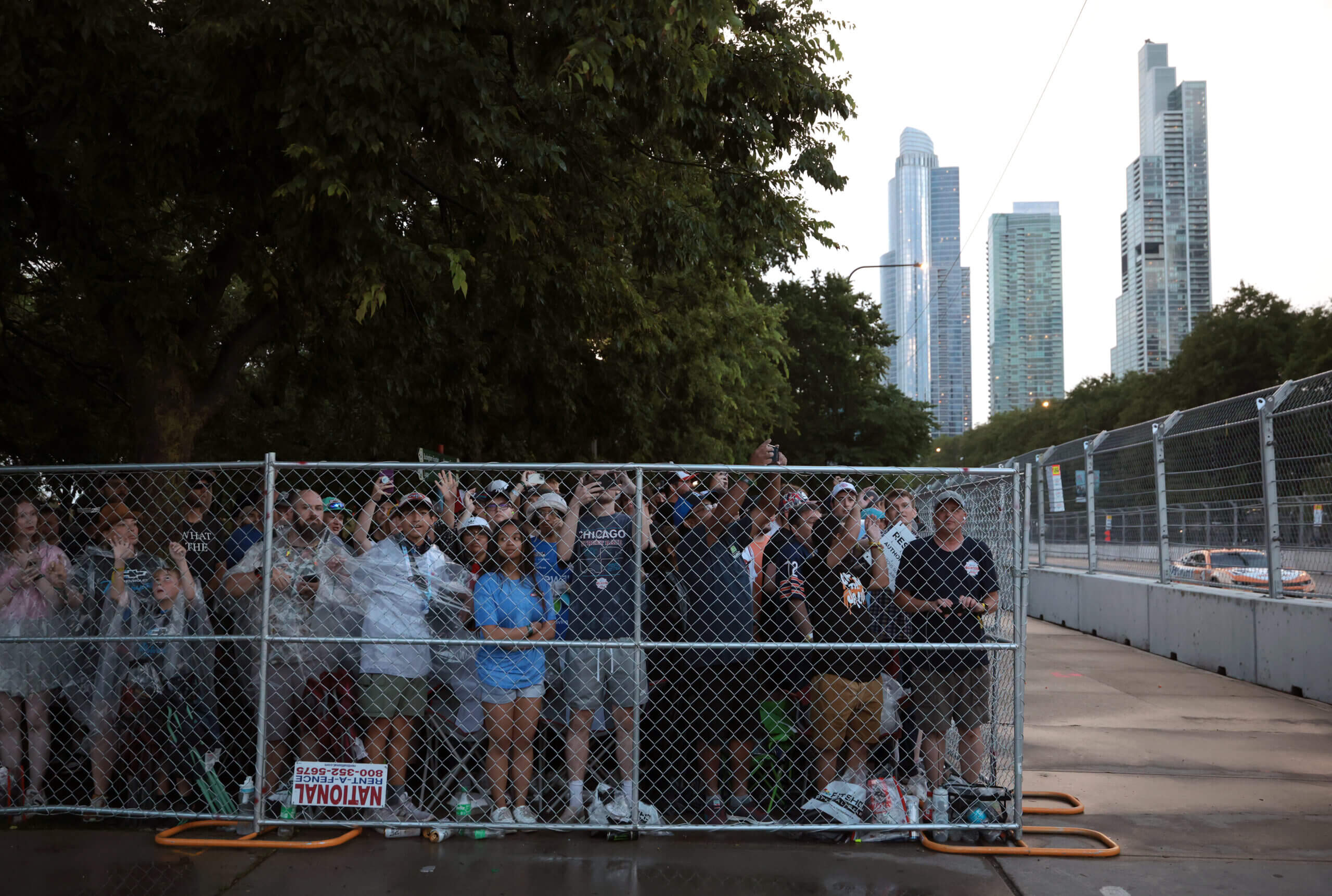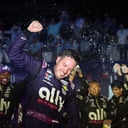CHICAGO — As a candidate in early 2023, Chicago Mayor Brandon Johnson has been reluctant to commit to supporting the downtown NASCAR street race he inherited from the previous administration. With significant opposition to NASCAR’s inaugural event last July, which drew grumblings about road closures and lack of park access for residents, Johnson has taken a wait-and-see tone, even after the race.
But Johnson, like many Chicagoans, now seems convinced. He not only attended the second annual Chicago Street Race on Sunday, but also praised NASCAR’s outreach efforts to the community to build unity.
“Seeing the diversity and the makeup of this room, you can’t tell me what’s not possible, not just for this city, but for this country,” Johnson said during a brief address to NASCAR Cup Series drivers at their pre-race meeting. “And who would have thought that the sport of NASCAR could bring this country together?”
Johnson was later seen wearing a blue NASCAR fire suit on pit lane as he prepared to take a lap of the 2.2-mile circuit in the safety car. But while the mayor has clearly embraced NASCAR’s presence in the city, a force even more powerful than Chicago politicians has not: Mother Nature.
Last year, the race’s opening weekend was marred by torrential rain and minor flooding, forcing NASCAR to shorten its two races and cancel three of the four concerts scheduled for what had been billed as a music and racing festival. And despite a rain chance of just 10 percent this year, showers arrived Sunday just before the scheduled green flag and then caused a lengthy delay when heavier precipitation made the track too dangerous.
Torrential rains once again denied NASCAR an unhindered opportunity to showcase its racing to potential new fans, which was the event’s primary goal. Thousands of people could be seen pouring out of the event’s gates during the delay, and only 128 miles of the scheduled 165 were completed before the race was halted due to darkness.
Most NASCAR races are held on ovals, and a significant number of them are held well outside of city centers. Chicago’s concept, similar to Formula One’s street racing around the world, was NASCAR’s attempt to bring its product directly to the people. The course includes famous roads like Michigan Ave. and DuSable Lake Shore Dr., winding through Grant Park with views of Chicago’s world-famous museums on Lake Michigan.
The festival’s concerts take place on the same main stage as Lollapalooza and this year featured big-name acts like The Black Keys and Keith Urban. Chicago blues legend Buddy Guy also performed, and NASCAR hosted a celebration of house music’s 40th anniversary. When NASCAR drivers appeared in front of a smaller-than-expected but enthusiastic crowd before the Chainsmokers’ concert Saturday night, most people raised their hands when asked if this was their first NASCAR race.
Those numbers are consistent with NASCAR data, which shows that about 60% of ticket buyers for the second edition of the street race had never purchased a NASCAR ticket before. Chicago Street Race President Julie Giese said 85% of buyers are attending their first NASCAR race in 2023, but she expects that number to drop somewhat for the second year.
“This event is about introducing our sport to a new audience, but I want people who participated last year to come back because they had a good time,” she said.
Giese said about half of the fans are local, while the rest have traveled abroad to attend the event; ticket buyers represented 23 different countries this year, compared to 15 in 2023. But tickets are priced significantly higher than most NASCAR races to offset the extreme costs (NASCAR said it spent more than $50 million on last year’s race), which may discourage some traditional fans from choosing Chicago over another track. And to entice non-NASCAR fans to take a chance on the event, it’s relying heavily on the concert lineup, the Gen Z-friendly atmosphere and the high-end hospitality options, which are much closer to F1 than typical NASCAR offerings.

Fans watch through a fence as NASCAR races in Chicago. NASCAR said 60 percent of ticket buyers for Sunday’s race were first-timers. (James Gilbert/Getty Images)
Despite the bad weather, the crowd was enthusiastic. Last year, two friends of NASCAR driver Chase Elliott even told him they wanted to attend the inaugural race. They had attended Elliott’s other races, of course, but they were intrigued by an event that was decidedly outside the NASCAR norm.
Their reaction?
“It’s the best race on the calendar. It’s the most fun race we’ve ever had,” Elliott recalled this weekend. “You have to listen to them because they’re not here every week. And when they come, they want a fun experience. That’s what we gave them.”
Instead of staying in their RVs parked in the infield of a regular track, all the drivers stayed in nearby hotels and walked across Michigan Avenue to the entrance of the course. Wearing backpacks and street clothes, they blended in with the crowd and were able to move around unnoticed by city dwellers and tourists passing by the Art Institute of Chicago or congregating at the nearby “Bean.”
Daytona 500 winner William Byron, for example, said Saturday that he went to the track without any interaction with fans. Drivers have embraced their relative anonymity not for convenience, but as a reminder of the purpose of the Chicago race.
“Curiosity is going to get the best of everybody,” two-time NASCAR champion Joey Logano said. “(People from the city) are going to come out here and want to see what’s going on. Even last year, you think about the people trying to look through the fence. They didn’t have a ticket, but they were trying to look through the fence to see the race cars and wondering, ‘What’s going on here?’”
“What’s wrong with that? Nothing.”
While the initial idea was that Chicago could serve as a test case for future NASCAR street races in other cities — whether in this country or abroad — drivers aren’t in a rush to move elsewhere just yet. Michael McDowell, a road racer who drove a White Sox car Sunday, said Chicago could become “one of those iconic street races” within a decade if the event continues.
NASCAR and Chicago have a three-year deal, but there are opt-outs. There is also a two-year extension option after the third year. So will the race return in 2025? There is no indication otherwise at this point, especially given the mayor’s enthusiasm after the city reworked its deal to get more money and saw NASCAR shave six days off the track’s construction time.
And Elliott, who acknowledged he’s not a city slicker but loves Chicago, cautioned the NASCAR industry against thinking it would be easy to replicate what the Windy City has offered so far — especially in terms of the racing itself.
“The course and the neighborhood it’s in, and the access to the park and everything that’s here, is really nice, and it’s given us the opportunity to have a really worthy track,” he said. “You’d be hard-pressed to have a track of this quality in a lot of other cities if you were to do something like this.”
And, after two years, no one has yet been able to see exactly what that quality could actually be in a long-distance Cup race without rain.

GO FURTHER
Alex Bowman, after his victory at the Chicago Street Race, can finally enjoy this bourbon
(Photo from Sunday’s Chicago street race: Jared C. Tilton/Getty Images)